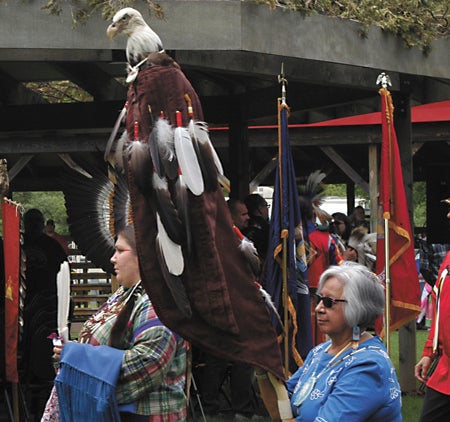Healing eagle staff visits pow wow
Published 5:03 pm Monday, May 27, 2013
Every feather tells a story.
Linda Woods wondered why she never saw a female veteran carrying an eagle staff at pow wows such as the fourth annual Oshke-Kno-Kewewen Saturday and Sunday at the Pokagon Band’s arena at Rodgers Lake on Sink Road.
Woods served in the U. S. Air Force in 1962-66 during the Vietnam era.
The retired nurse belongs to the Grand Traverse Band of Ottawa and Chippewa Indians and is believed to be the first American Indian woman in the state or nation to carry a ceremonial eagle staff she calls Migizi.
Migizi is the Odawa word for eagle.
Eagles and their feathers are regarded as sacred in native culture and spiritual traditions because they fly highest, carrying prayers to the Creator and messages back to Earth in many forms, symbolizing strength, courage, healing and wisdom.
“She fell from the sky in a blizzard up by Cheboygan. She fell into the Black River. Evidently, she was electrocuted” hitting a power line, Woods said. “A friend of mine named Perry (Neuman, a Sault Ste. Marie Tribe of Chippewas member who lives near the river and is familiar with ceremonies surrounding an eagle’s death) heard about it and went to look for this fallen warrior. He solicited two men, one a (Vietnam) combat veteran, Tony Grondin, and my friend, Billy Nash.
“When they finally found her,” Woods related, “she was encased in a five-foot block of ice in the river. They proceeded to bring the ice block with the help of Perry’s dog, a bloodhound named Lily, which found feathers which fell in the snow. That was in 2008. In (a ceremony on Dec. 3) 2011, they presented her to me. I knew immediately what I was supposed to do, but I didn’t know how to make an eagle staff. I didn’t have a clue.”
Woods pointed out two feathers on the back of the staff, one white, one red.
“When warriors came home in the old days, they wore a red feather or had a feather with red on it. The white feather was found by a grandma from the Little Traverse Bay Band who found it in a dump in Alaska. She was discouraged from picking it up, but said, ‘I’m going to clean it up and take it home. Somebody helped clean me up. I know this feather is going to be beautiful,’ so this white feather represents healing and the red feather represents our woundedness. Many women in the military have been assaulted, prejudiced against and suffer from PTSD (Post Traumatic Stress Disorder) also. They suffer from alcohol and addictions and domestic violence. This staff is for those women.”
The first feather she affixed to the staff is black.
“It’s for Lori Piestewa,” Woods said.
Piestewa (Dec. 14, 1979-March 23, 2003) was a U.S. Army Quartermaster Corps soldier killed during the same Iraqi Army attack in which fellow soldiers Shoshana Johnson and Jessica Lynch sustained injuries.
A member of the Hopi tribe, Piestewa was the first Native American woman in history killed in combat while serving with the U.S. military and the first woman in the U.S. armed forces killed in the 2003 invasion of Iraq. Arizona named Piestewa Peak in her honor.
“All these feathers have stories,” Woods said. “There’s a reason they’re on there.”







